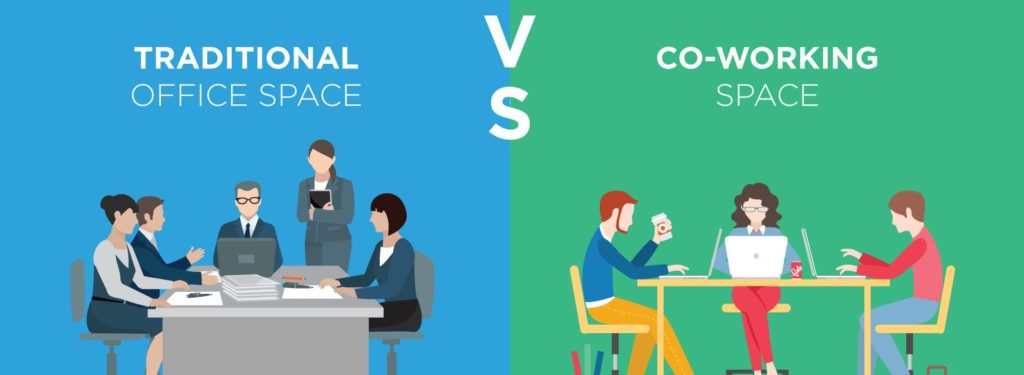
Coworking vs. Traditional Office Space
By: STEVE GILLESPIE—
When starting a business, there are thousands of decisions to make. One of those is whether or not you need a traditional office space. You could set up shop in a coworking space but which is better for your company? Coworking vs. traditional office space is a question with a different answer for every business.
Pros of Coworking Space
Coworking spaces have some good benefits. They provide to a wide range of professionals in different fields. This can create a valuable network of connections that could improve your business. Employees can share ideas, knowledge, and insights. Collaboration happens naturally in coworking environments.
Coworking spaces can also offer more flexibility. With an increase in remote workers and cloud-based companies, flexibility has become very important. Coworking leases are usually short-term and allow you to reevaluate your office space needs often. Move-in dates are typically soon after lease signing.
Most coworking locations often have a membership fee. There can be different membership levels based on what you need, but the membership price will include operating and overhead costs. These costs include general office maintenance, cleaning, utilities, and high-speed internet. There is usually a shared receptionist, mail service, kitchen with beverages, phone booths for private calls, and communal meeting / conference rooms too.
Cons of Coworking Space
While coworking spaces are becoming more popular, there are some downsides to the shared work environment. They can get very loud and distracting. People are coming and going at all times of the day since employees of different companies will keep varying schedules. There is less privacy in coworking spaces and you are sharing an office with people you don’t know. Dealing with confidential information can be of concern. Also as your company grows, coworking spaces typically become much more expensive than traditional office space.
Pros of Traditional Office Space
In a traditional office space, you are in control of your own work space. Your employees are able to work in a private office area without having to worry about others with different schedules. It is quieter and less distracting. A traditional office space gives a more established sense to your brand. Also with a growing company, office space will become more cost-efficient on a square foot per capita basis in a traditional office space.
Cons of Traditional Office Space
There are some downsides to traditional work spaces. Since you are in charge of the entire suite, you pay for everything. This includes all operating costs like internet, cleaning, utilities, and more. You will also be responsible for the cost of the reception area, break room, and furniture for your entire suite. In addition to paying to build and maintain these spaces, you also will have to staff them.
Maintenance and utilities can add up. You will often have to renegotiate agreements. You may even have to eliminate some amenities. Leases for traditional office suites are typically for three to ten years. They usually include annual rent increases and require upfront security deposits equivalent to a minimum of one month’s rent.
Is Coworking or Traditional Office Space Best for Your Business?
When considering coworking vs. traditional office space you must realize which benefits outweigh the cons for your business. It is best to first determine what is important for your company. If you want to keep costs low, agreements to short duration, and are not concerned with how the office is run, a coworking space might be a good choice. On the other hand, if you are willing to juggle the different costs associated with renting your own space, then you get more privacy (and often a better value) with a traditional office space.
Visit the article at: TexasOfficeAdvisors
Photo credit: https://medium.com/@greenhouse.id/co-working-space-vs-traditional-office-an-infographic-eedc1cc525db

